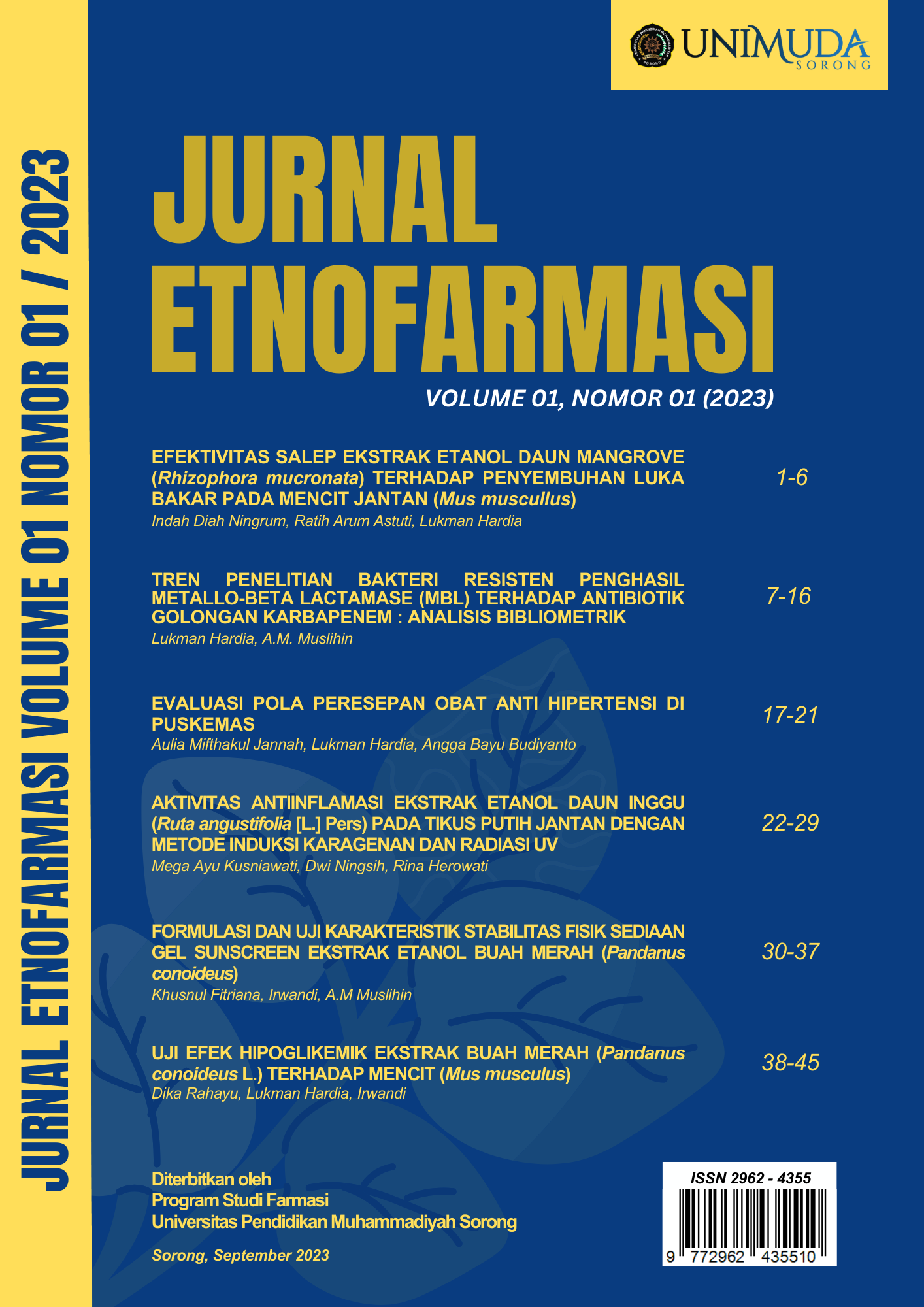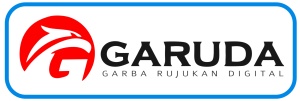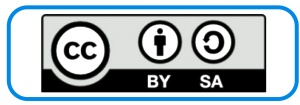FORMULASI DAN UJI KARAKTERISTIK STABILITAS FISIK SEDIAAN GEL SUNSCREEN EKSTRAK ETANOL BUAH MERAH (Pandanus conoideus)
Abstract
Radiasi sinar ultraviolet yang diterima tubuh secara berlebih mengakibatkan pengaruh buruk pada kulit dapat muncul bintik hitam pada kulit, eritema, elastosis, penuaan dini, hingga dapat menghambat sistem kekebalan tubuh menjadi salah satu pemicu kenker kulit. Tumbuhan di papua yang mengandung antioksidan tinggi yaitu buah merah (Pandanus conoideus). Untuk memudahkan masyarakat dalam hal penggunaan, buah merah dapat diformulasikan menjadi sediaan gel sunscreen. Sediaan gel terpilih sebab lebih praktis mudah menyerap, membentuk lapisan film yang mudah dibersihkan dan memberikan efek rasa dingin pada kulit. Tahapan dalam penelitian ini adalah persiapan sampel, formulasi gel sunscreen konsntrasi 10 %, uji karakteristik fisik, uji stabilitas fisik dan uji in vitro sediaan gel sunscreen ekstrak etanol buah merah. Hasil penelitian yang telah dilakukan didapatkan hasil ekstrak kental buah merah sebanyak 154,5 gram dari simplisia kering sebanyak 1000 gram sehingga rendemen ekstrak yang diperoleh adalah 15,45%. Hasil pengujian karakteristik fisik, stabilitas fisik sedian gel sunscreen ekstrak etanol buah merah konsentrasi 10 % baik. Ekstrak etanol buah merah dapat diformulasikan menjadi sediaan gel sunscreen konsentrasi 10 % memiliki karakteristik dan stabilitas fisik baik nilai SPF 23,5474 dengan kemampuan menangkal paparan sinar matahari yang baik.
Downloads
References
Ansel, H. C. (1989). Introduction to pharmaceutical dosage forms (4). Jakarta: Universitas Indonesia Press.
Hastuti, R., Endah, S. R. N., & Nofriyaldi, A. (2020). Formulasi dan Uji Stabilitas Fisik Sediaan Gel Ekstrak Daun Alpukat (Persea americana Mill). Pharmacoscript. 3: 150-161.
Ilham Hasan, I., Samia, A.R., Dorjaya A. K., & Anwar, S.P. (2013). Sunscreens dan Antiosidant sebagai agen perlindungan fotoprotektif. An update. Our Dermatology Online, 4(3), 369- 374. doi:10.7241/ourd.20133.92
Kumesan YAN., Yamlean PVY., dan Supriati (2013). Formulasi dan Uji Aktivitas Antijerawat Ekstrak Umbi Bakung (Crimun Asiaticum L.) Terhadap Bakteri Staphylococcus aureus Secara In Vitro. Pharmacon. 2(2).
Lin, Q., Xu Xu, R. H. J., Yang, N., Karim, A. A., Loh, X. J. & Zhang, K. (2019). Perlindungan UV dan Aktivitas Antioksidan dari Nanodiamonds dan Fullerene untuk Formulasi Tabir Surya. ACS Applied Nano Materials; 2; 7604–7616.
Naibaho, O. H.L., Wiyono, W. & Yamlean, P. A. V., (2013). Effect of Ointment Base on Ointment Formulation of Basil Leaves Extract (Ocimum sanctum L.) on the Back Skin of Rabbits Made with Staphylococcus aureus Infection. Pharmacon, 2(2).
Neni S. Gunarti, Lia Fika Y. (2019). Formulation and activity test of sunscreen gel from blackberry fruit extract (Rubus fruticosus) in vitro by Uv-visible spectrophotometry. Pharmaceutical Scientific Journal, 7, 68-72.
Nurlely, Aulia R, Prima H. R, Valentina M. S, Khoerul A. (2021). Test of Physical Characteristics of Kirinyuh Leaf Extract (Chromolaena odorata L.) Gel with Carbopol and HPMC Variations. Jurnal Pharmascience. 8. 2.
Pertiwi, R. D., Kristanto, J., & Praptiwi, G. A. (2016). Antibacterial Activity Test of Gel Preparation Formulation for Thrush from Saga Leaf Extract (Abrus precatorius Linn.) Against Staphylococcus aureus Bacteria. Manuntung Scientific Journal. 2: 239-247.
Putri W. A., Anindhita M.A, (2022). Optimasi formula gel ekstrak etanol buah kapulaga dengan kombinasi gelling agent HPMC dan Natrium Alginat menggunakan simplex lattice design. (Scientific Journal of Pharmacy).
Rahmawati, A. Muflihunna, and Meigita A. (2018). Analysis of UV Protection Activity of Soursop (Annona Muricata L.) Juice Based on Sun Protection Factor (SPF) Value by UV-Vis Spectrophotometry. Indonesian Phytopharmaca Journal 5. 284–88.
Sartika S. Wulandari, M.R.J. Runtuwene, Defny S. W. (2017). Aktivitas Perlindungan Tabir Surya Secara In Vitro Dan In Vivo Dari Krim Ekstrak Etanol Daun Soyogik (Sauraunia bracteosa DC). Pharmacon vol. 6 no. 3.
Sayuti, N. A. (2015). Formulation and Physical Stability Test of Chinese Ketepeng Leaf Extract Gel (Cassia alata L.). Indonesian Pharmaceutical Journal. 5: 74-82.
Shukr MH, Metwally GF. Evaluation of topical gel bases formulated with variousessential oils for antibacterial activity against methicillin-resistant Staphylococcus aureus. Pharmaceutical Research. (2013);12 (6):877-84
Slamet slamet., Bibah Dewi Anggun., Dwi Bagua Pambudi. (2020). Uji Stabilitas Fisik Formula Sediaan Gel Ekstrak Daun Kelor (Moringa Oleifera Lamk.). Jurnal Ilmiah Kesehatan. 13: 2. Utami, R. R., Armunanto, R., Rahardjo, S., & Supriyanto. (2016). Pengaruh Fermentasi Biji Kakao (Theobroma cacao L.) terhadap Kandungan Fenolik, Aktivitas Antioksidan dan Gugus
Fungsi Cangkang Biji Kakao. Pakistan Journal of Nutrition; 15; 948-952.
Yanti Eff, A. R., Rahayu, S. T., Saraswati, H., & Munim, A. (2019). Formulation and Evaluation of Sunscreen Gels Containing Mangiferin Isolated from Phaleria macrocarpa Fruits.
International Journal of Pharmaceutical Investigation, 9(3), 141–145.
Yati, K., Jufri, M., Gozan, M., Mardiastuti & Dwita, L. P. (2018). Effect of Hydroxy Propyl Methyl Cellulose (HPMC) Concentration Variation on Physical Stability of Tobacco Extract Gel (Nicotiana tabaccum L.) and Its Activity against Streptococcus mutans.Pharmaceutical
Sciences and Research (PSR). 5: 133 – 141.
Yunita Ni Nyoman Tri Sukartiningsih, Hosea Jaya Edy, Jainer Paca Siampa (2019). Formulasi
Sediaan Gel Ekstrak Etanol Daun Kaliandra (Calliandra surinamensis Benth) Sebagai Antibakter i. PHARMACON.
Copyright (c) 2023 Khusnul Fitriana, Irwandi, A.M. Muslihin

This work is licensed under a Creative Commons Attribution 4.0 International License.








